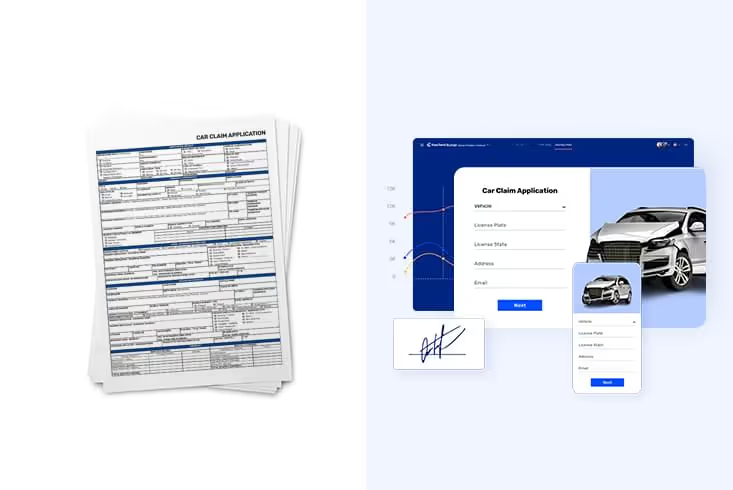This process is time-consuming for the customer, but it is also inefficient and costly for the insurance company. There are many reasons why digital front-end customer data collection is superior to manual processes and PDF forms.
Digital front-end customer data collection:
- Fast and efficient
- Reduces errors
- Provides a better customer experience
Let's take a closer look at each of these advantages
Customer data collection process in insurance
Insurers must collect multiple types of data from customers, both structured and unstructured, including:
- Personal information (e.g., name, address, date of birth)
- Policy information (e.g., type of coverage, premium amount)
- Claim information (e.g., details of the incident, repair estimates)
The data comes in multiple formats, including free-form text, photos, videos, scanned documents, and signatures. It can be challenging for insurers to manage this data manually.
[.emph]Data must be collected, verified for accuracy, and entered into the system. This is a time-consuming process that is prone to errors.[.emph]

Common customer data collection methods: pros and cons
There are several common methods for customer data collection:
- Paper forms
- PDF forms
- Online forms
- Digital interfaces/ Digital intake journeys
Each of these methods has its own set of pros and cons. Let's take a look at each one in turn.
Paper forms
Collecting data on paper forms is the most traditional method. The customer fills out the form by hand, and then mails it back to the insurance company.
Pros:
- Can be used offline
- Easy to use
Cons:
- Time-consuming for customer
- Inefficient and costly for company
- Errors are common
PDF forms
PDF forms are similar to paper forms, but the customer fills them out electronically, and then email them back to the company.
Pros:
- Can be used offline
- Faster than paper forms
Cons:
- Inefficient and costly for company
- Errors are common
Online forms
Online forms are completed entirely online, and the data is sent directly to the insurance company's database.
Pros:
- Fast and efficient
- Reduces errors
Cons:
- Requires an internet connection
- User experience is often lacking
Digital interfaces
Digital data collection processes or journeys allow customers to input their data directly into the insurance company's system via a digital interface. Digital intake journeys offer a user-friendly way for customers to submit their information.
A digital data intake journey is a guided process that takes the customer through a series of steps, such as inputting their data, uploading documents, and signing paperwork. Because digital data intake journeys collect customer data through a series of interactive steps, rather than a complex form, they are more user-friendly and efficient than web forms. Digital journeys can also dynamically adapt to customer input, which further improves the customer experience.
Pros:
- Fast and efficient
- Reduces errors
- Provides a better customer experience
Cons:
- Requires an internet connection
- Can be costly to develop
As you can see, digital front-end customer data collection has many advantages over traditional methods.

What is customer data intake automation?
Customer data intake automation is the process of collecting customer data electronically, typically through a digital process or web form.
[.emph]Customer data intake automation is collecting customer data electronically, without the need for manual processes.[.emph]
In the insurance industry, customer data intake automation is used to collect policyholder information, signatures, and supporting documentation. Automated systems can be used to create an electronic file of all the information collected, which can then be stored in a secure database.

Advantages of customer data intake automation
Customer data intake automation has many advantages, both for customers and insurers.
Faster and more efficient
One of the key advantages of customer data intake automation is that it is faster and more efficient than manual processes. Automated systems can collect data from multiple sources and then parse and store it in a secure database. The whole process takes place without involvement from company employees, saving time.
Improved accuracy
In addition, automated systems can validate data at the point of entry, reducing the potential for errors. This saves back-and-forth time between the customer and insurer, as well as the time needed to correct errors.
Better customer experience
Another advantage of customer data intake automation is that it provides a better customer experience. Customers are used to interacting with businesses online and expect a streamlined, personalized experience.
End-to-end automation
Digital customer data intake changes the way your business operates, from front to back. It begins with automating the customer-facing forms used to collect data and signatures. Once the customer submits the form, the data is automatically routed to the appropriate department or individual.
This process eliminates manual workflows, saving time and reducing errors. In addition, it provides a better experience for both customers and employees who appreciate the convenience and streamlined process.
The issues with PDF forms
PDF forms are a standard data collection method. When fillable PDFs were first introduced, they were considered a breakthrough. PDFs were the perfect solution for businesses that needed to collect data from customers but didn't want the hassle of paper forms.
[.emph]However, PDFs have several drawbacks and today, they are viewed as antiquated. [.emph]
PDFs present several problems when it comes to user experience standards in 2022. PDF forms are:
- Not mobile-friendly. Customers expect to do everything on their phone, but PDFs are a nightmare to fill in on mobile devices and small screens.
- Not easy to use. Many customers find PDF forms confusing and difficult to fill in.
- Not accessible. PDFs are not easily accessible for people with disabilities.
- Not secure. PDFs can be easily altered, which creates security risks.
- Not editable. Once a PDF form is filled in, it cannot be edited without creating a new copy. This makes it difficult to correct mistakes.
- Cannot be validated in real-time. You cannot ensure that the data entered into a PDF form is valid until the form is submitted. This can lead to errors and delays in processing.
- Not shareable in real time. It is not possible to share a PDF form with multiple people in real-time, which makes collaboration difficult.
Digital front-end customer data collection
A digital front-end customer data collection is a customer-facing interface that allows customers to input their data, upload documents and sign paperwork fully digitally. It is the opposite of a manual process, where an agent receives the data in a different format and then inputs customer data into the company's systems manually.
If you're still using manual processes and PDF forms to collect customer data, it's time to make the switch to customer data intake automation. It will save you time and money, but it will also improve the customer experience.

What are the benefits of customer data intake automation?
There are many benefits of customer data intake automation, both for the insurance company and the customer.
For the insurance company, some of the benefits of automation include:
- Fewer errors and quicker turnaround times
- More complete and accurate data
- Improved tracking and management of customer data
- Reduced processing costs
For the customer, some of the benefits of automation include:
- A streamlined, personalized experience
- Quick and easy data entry
- The ability to sign documents electronically
- No need to print, sign, and scan paper forms
How to implement customer data intake automation
There are two main methods for digital customer data intake: web forms and digital journeys.
Web forms
Web forms are the most common method of digital customer data intake. They can be embedded on a website or used as a standalone form.
The advantages of using web forms for customer data intake include:
- Accessible from any device with an internet connection.
- Can be customized to match the look and feel of your website.
- Can be easily shared via email or social media.
- Can be integrated with other software, such as CRM systems.
The drawbacks of webforms, include:
- They can be confusing for customers to fill in, especially for complex forms that require a lot of information from the customer
Digital journeys
Digital journeys are a newer method of customer data intake that is becoming increasingly popular.
[.emph]A digital data intake journey is a guided process that takes the customer through a series of steps, such as inputting their data, uploading documents, and signing paperwork.[.emph]
Because digital data intake journeys collect customer data through a series of interactive steps, rather than a single form, they are more user-friendly and efficient than web forms. Digital journeys can also dynamically adapt to customer input, which further improves the customer experience.
The advantages of digital journeys include:
- Provide a streamlined, step-by-step experience for customers.
- Can be customized to the needs of each customer.
- Can be accessed on any channel, including the website, mobile app, and call center.
- Can be integrated with other software, such as CRM systems, empowering personalization and a consistent customer experience across channels.
The disadvantages of digital journeys include:
- Digital journeys can be time-consuming to set up and maintain.
- Digital journeys require a greater investment in technology.

Which method is right for you?
Both web forms and digital journeys have their advantages and disadvantages. Digital journeys offer superior customer experience, but they require a greater investment in technology. That is why they are typically used by larger businesses with more complex customer data requirements.
Web forms have some drawbacks in terms of customer experience, but are a more basic form of customer data intake that is less expensive and time-consuming to set up. They are typically used by small businesses with simple customer data requirements.
However, no-code digital journey platforms are changing that. Now, businesses of all sizes can create digital journeys without the need to invest in costly technology or hire developers.
[.emph]A no-code digital journey platform is a type of software that enables businesses to create digital journeys without writing any code. This makes digital journeys a viable option for businesses of all sizes.[.emph]
The advantages of using a no-code digital journey platform include:
- Easy to use and do not require any coding skills.
- Less expensive than hiring a developer to build a custom solution
- Can be quickly implemented and do not require a long development time.
The main disadvantage of using a no-code digital journey platform is that they may not be as flexible as a custom-built solution. However, they offer a much lower barrier to entry and are a good option for businesses that want to start using digital journeys without a large investment.

How to choose a digital customer data intake platform
When choosing a digital customer data intake platform, there are a few key factors to consider:
- The needs of your business: First, you need to assess the needs of your business in terms of customer data requirements. If you have simple customer data requirements, a web form may be sufficient. If you have more complex customer data requirements, or if you want to provide a superior customer experience, a digital journey is likely a better option.
- The size of your business: Small businesses typically do not have the resources to invest in costly technology or hire developers. In this case, a no-code digital journey platform is a good option. Larger businesses may have the resources to invest in custom-built digital journeys, but no-code digital journey platforms can still be a good option for quickly implementing digital journeys without a large investment.
- The budget of your business: Digital journeys typically require a greater investment than web forms, so you need to consider your budget when deciding which option is right for you. If you have a limited budget, a no-code digital journey platform may be a good option.
No matter what size business you have or what your customer data requirements are, customer data intake automation can save you time and improve the customer experience. By automating the process of customer data collection, you can focus on other areas of your business and provide a better experience for your customers.
Digital customer data intake is the future of customer data collection. If you are not using it, you are at a competitive disadvantage. Ready to get started? Check out our no-code digital journey platform that empowers Fortune 500 insurance companies to overhaul their customer data intake process and improve customer engagement.
.avif)



.avif)
.avif)


.avif)
